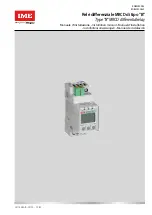
I.L. 41-490H
18
12. ROUTINE MAINTENANCE
The relays should be inspected periodically, at such
time intervals as may be dictated by experience, to
insure that the relays have retained their calibration
and are in proper operating condition.
All contacts should be cleaned periodically. A con-
tact burnisher #182A836H01 is recommended for
this purpose. The use of abrasive material for clean-
ing contacts is not recommended because of the
danger of embedding small particles on the face of
the soft silver and thus impairing the contact.
See Appendix B for additional information.
12.1 Distances Units
CAUTION
!
Before making “hi-pot” tests, jumper all contacts
together to avoid destroying arc suppressor ca-
pacitors.
For effective and quick maintenance it is advisable
to repeat the acceptance test with the field settings.
Then use portable test equipment such as the
K-DAR test set (I.L. 41-493.1) to record K-DAR test
set dial readings. In the future all field tests can be
made with the K-DAR test box just by referring to the
previous dial readings without using more elaborate
test set up of Figure 26. When testing with S=2, dou-
ble the test voltage. When testing with S=3, triple the
test voltage. Note that KD-11 reach and maximum
torque angle are increased with the lower T-settings
(see Section 4.5, Distance Characteristics: KD-11,
3-Phase Unit).
12.2 Indicator Contactor Switch (ICS)
Close the main relay contacts and pass sufficient dc
current through the trip circuit to close the contacts
of the ICS. The current should not be greater than
the particular ICS tap setting being used for the
0.2-2.0 amperes ICS. The operation indicator target
should drop freely.
13. REPAIR CALIBRATION
See Appendix B for additional information and for
trouble shooting limits.
Use the following procedure for calibrating the relay
if the relay has been taken apart for repairs or the ad-
justments disturbed.
Connect the relay for testing as shown in Figure 25.
Figure 26 shows a four-pole-double-throw switch in
the test circuit that selects a phase-to-phase or a
three-phase fault voltage condition, that will be ap-
plied to the relay voltage terminals. The rotary switch
switches the fault voltage to various terminals and
thereby simulates any phase combination of the
phase-to-phase fault without the tester having to
change connections or readjust the phase-shifter
and variable auto-transformers.
For best results in checking calibration, the relay
should be allowed to warm up for approximately one
hour at rated voltage in a case. However, a cold re-
lay will check to within three percent of the warm re-
lay. The relay may be calibrated outside the case.
13.1 Initial Spring Setting
Set the moving contact spring adjuster so that the
contact floats freely in the gap. Make sure that there
is no friction which prevents free movement of the
cylinder and contact arm.
13.2 Shaft Clearance
The upper pin bearing should be screwed down until
there is approximately .025 inch (one complete turn
of the screw) between it and the top of the shaft
bearing. The upper pin bearing should then be se-
curely locked in position with the lock nut. The lower
bearing position is fixed and cannot be adjusted.
13.3 Auto-Transformer Check
Auto-transformers may be checked for turns ratio
polarity by using the No. 1 test connections of Figure
25, and the procedure outline below.
Set S, S
A
, and S
C
on tap number 3. Set the “R” leads
of M, M
A
, M
C
all on 0.0 and disconnected all the “L”
leads. Adjust the voltages V
1F2F
and V
2F3F
for 90
volts. Measure the voltage from terminal 8 to the #1
tap of S and S
A
. It should be 29.4 volts. From 8 to the
#2 tap of S and SA should be 58.6 volts. The voltage
should read 29.4 volts from 8 to S
C
= 1 and 58.6 volts
from 8 to S
C
= 2.
Set S, S
A
, and S
C
on 1 and adjust V
1F2F
and V
2F3F
for 100 volts. Measure the voltage drop from termi-
















































